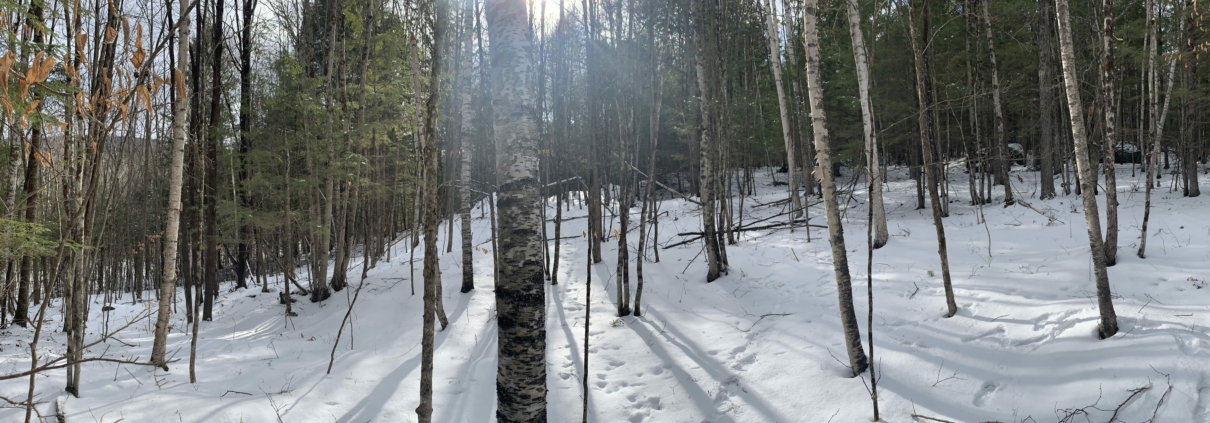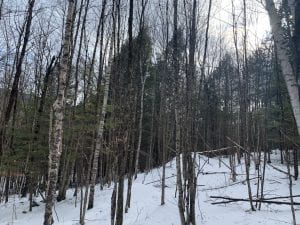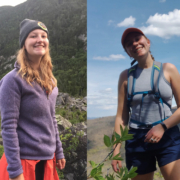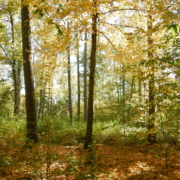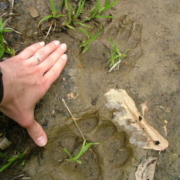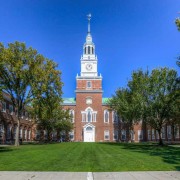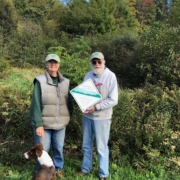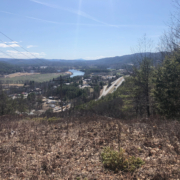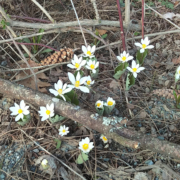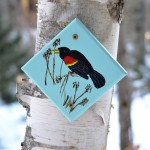Why Are Paper Birch Trees So White?
By Michael J. Carlowicz Jr., Dartmouth Class of 2022
Betula papyrifera, or the paper birch tree, is a common sight for hikers in northern North American forests. As the state tree of New Hampshire, the paper birch can be easily identified by its white-colored bark, which peels off in thin paper-like layers. Most trees have dark brown or grey bark, but the paper birch almost blends in with the snow. So why is the paper birch tree so white?
One major risk to paper birch trees during the winter is frost cracking, or the splintering of the tree trunk due to sunlight. When trees heat up during a day in the sun, their trunks swell due to thermal expansion. Then, when night falls and temperatures plummet, the outside layers of the trees cool and contract faster than the internal layers, squeezing the tree with its own bark. The outer layers squeeze with so much force that trees can snap their own trunks. This process kills trees, so paper birch trees need defenses against soaking up too much sunlight.
The bright white of the paper birch tree relates to a property called albedo, or how much light is reflected or absorbed by an object’s surface. Anyone who has worn a black shirt in the summer already knows that dark colors absorb lots of sunlight. The reverse is also true: lighter colors reflect sunlight. Since the paper birch tree has very bright bark, it can reflect more sunlight, decreasing the effect of thermal expansion and reducing the risk of frost cracking.
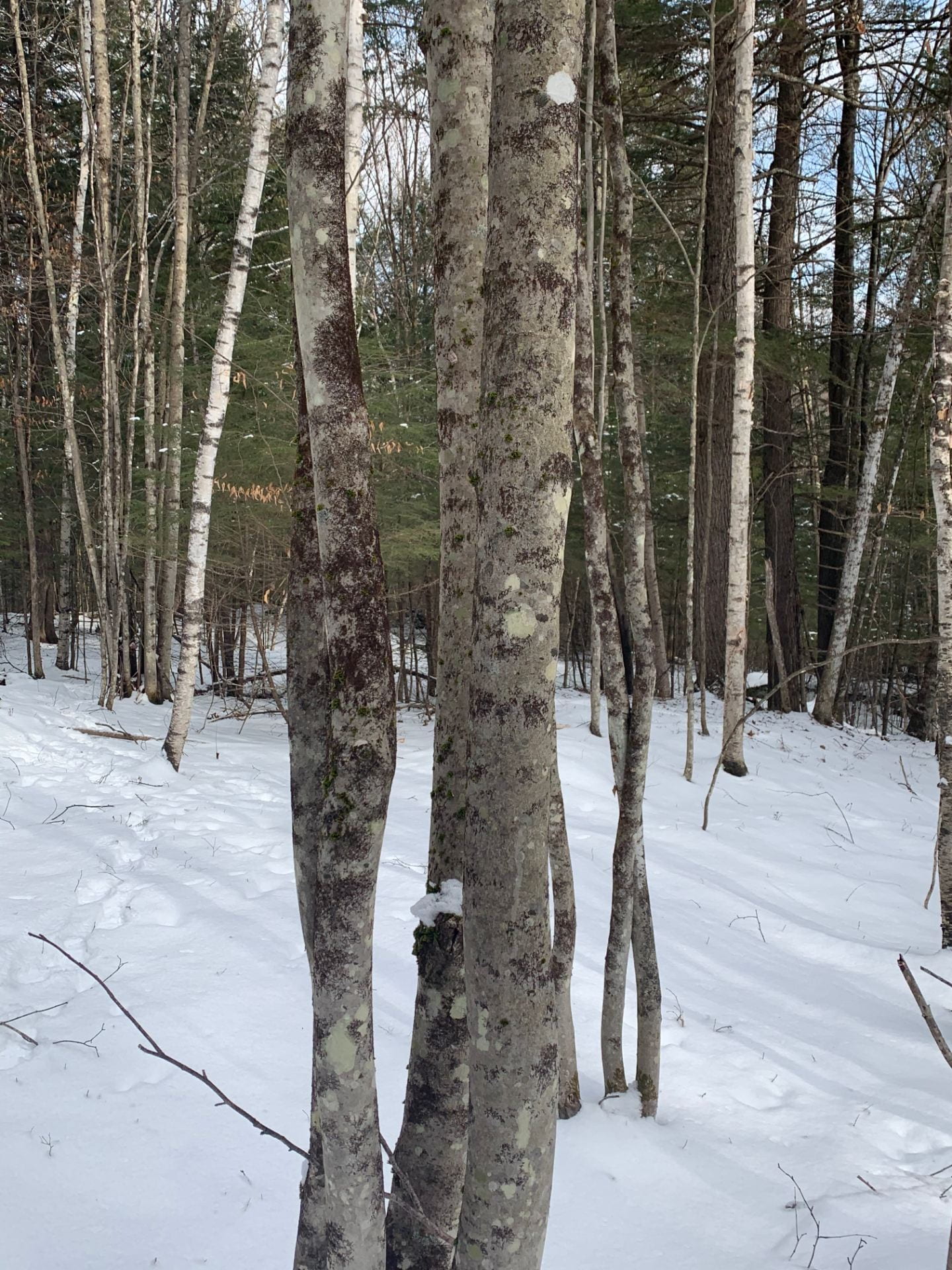
Three beech trees in Lyme Hill Conservation Area. Beech trees have darker-colored bark than paper birch trees. Photo by Mike Carlowicz. 23 Jan 2021.

Two paper birch trees in Lyme Hill Conservation Area. Paper birch trees have significantly lighter-colored bark than most other trees. Photo by Mike Carlowicz. 23 Jan 2021.
In order to better understand this possible defense strategy, I studied several paper birch trees and other nearby trees for two months in midwinter in Lyme Hill Conservation Area, owned and managed by the Upper Valley Land Trust. Specifically, I tried to answer the question: do paper birch trees have lower surface temperatures than darker colored trees? If lighter-colored bark protects paper birch trees from heat-related injuries, then those trees should exhibit lower surface temperatures than neighboring darker trees.
After several weeks of study, I came away with a much more complicated answer than I expected. While paper birches tend to exhibit lower surface temperatures than darker trees, there is a lot a variation in this trend. Many factors appear to influence tree surface temperatures, including air temperature, sun exposure, cloud cover, and tree trunk diameter. One of my most interesting findings was that temperatures can vary substantially across the surface of a single tree, whether light or dark, with higher sections being up to 6.6°C (12°F) hotter than lower sections. Though this trend was not consistent among trees, it certainly raises more questions about the distribution of heat across their surfaces.

Surface temperatures of birch and dark trees. Although not statistically significant, the difference in surface temperatures between birch and dark trees suggests that light colored bark allows birch trees to maintain lower surface temperatures than darker trees. Each dot represents the mean of each group. Each error bar is constructed using a 95% confidence interval of the mean.
My time working on Lyme Hill reminded me that the answers to some questions are not always simple, as there are many complex factors interacting in nature. That said, some relationships stay simple: it only takes one abnormal warming event to kill a tree by frost cracking. It is this simple relationship that makes it so important to study the complex ones. Climate change is predicted to cause more frequent and intense warming and cooling events in New Hampshire forests. It is crucial for scientists and hikers alike to understand the complex factors that affect the paper birch so that we can protect our forests from climate-driven destruction.
References and Additional Reading:
- Derby, R., & Gates, D. (1966). The Temperature of Tree Trunks-Calculated and Observed. American Journal of Botany, 53(6), 580-587.
- Harvey, R. (1923). Relation of the Color of Bark to the Temperature of the Cambium in Winter. Ecology, 4(4), 391-394.
- Karels, T.J., & Boonstra, R. (2003). Reducing Solar Heat Gain during Winter: The Role of White Bark in Northern Deciduous Trees. Arctic, 56(2), 168-174.
- Safford, L.O., Bjorkbom, J.C., & Zasada, J.C. Betula papyrifera U.S. Forest Service. U.S. Department of Agriculture. <www.srs.fs.usda.gov>. Downloaded on 16 March 2021.
Acknowledgements:
Special thanks to the Upper Valley Land Trust for allowing me to study the paper birch trees on their land at Lyme Hill Conservation Area.
Michael Carlowicz Jr. is a member of the class of 2022 at Dartmouth College. He currently studies biology with a focus on ecology, and he aspires to be an ocean scientist. The research for this blog post was conducted for course credit in “Biology 31: Physiological Ecology,” taught by Professor Jessica Trout-Haney. Though Mike usually prefers to walk on the beaches near his home on Cape Cod, walking on Lyme Hill taught him to appreciate the beauty of snow-covered New Hampshire forests.

